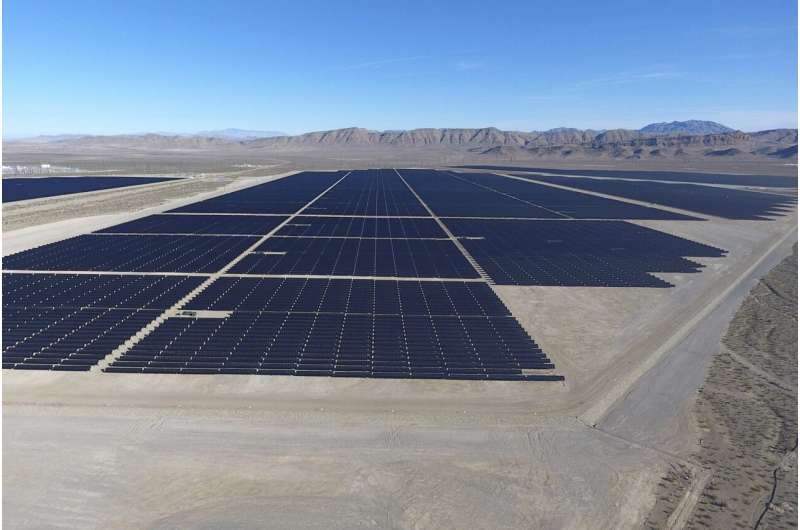In this Dec. 11, 2017, file photo, solar arrays line the desert floor of the Dry Lake Solar Energy Zone as part of the 179 megawatt Switch Station 1 and Switch Station 2 Solar Projects north of Las Vegas. The Biden administration on Tuesday, Dec. 21, 2021, issued a solicitation for interest in developing solar power on public lands in Nevada, New Mexico and Colorado. Credit: Michael Quine/Las Vegas Review-Journal via AP, File
U.S. officials moved Tuesday to open public lands in portions of three western states to potential solar energy development, as part of the Biden administration's effort to counter climate change by shifting from fossil fuels.
The U.S. Bureau of Land Management issued a call to nominate land for development within "solar energy zones" in Colorado, Nevada and New Mexico that combined cover about 140 square miles (360 square kilometers).
The solicitation of interest comes as officials under Democratic President Joe Biden promote renewable wind and solar power on public lands and offshore to reduce greenhouse gas emissions that are warming the planet.
BLM Director Tracy Stone-Manning said in a statement that government support for renewable energy was a top priority for the agency, which oversees almost a quarter-billion acres of land primarily in western states.
The land bureau in early December issued a draft plan to reduce rents and other fees paid by companies authorized to build wind and solar projects on public lands.
The recent actions mark a pronounced shift from Republican President Donald Trump's emphasis on coal mining and oil and gas drilling.
The Biden administration was unsuccessful in an attempt to suspend oil and gas sales from public lands and waters, after a judge ordered sales to resume following a lawsuit from Republican-led states. Biden suffered another huge blow to his climate change agenda this week, as opposition from West Virginia Democrat Sen. Joe Manchin tanked the administration's centerpiece climate and social services legislation.
The solar development zones were first proposed under the Obama administration, which in 2012 adopted plans to bring utility-scale solar energy projects to public lands in six states: Arizona, California, Colorado, Nevada, New Mexico and Utah. Officials to date have identified almost 1,400 square miles (3,500 square kilometers) of public land considered for potential leasing for solar power development.
If all that land were developed, the bureau says it could support more than 100 gigawatts of solar power, or enough electricity for more than 29 million homes. Current solar production from federal lands is a small fraction of that amount.
In November the land bureau awarded solar leases for about 8 square miles (19 square kilometers) of land in Utah's Milford Flats solar zone. Solar leases are expected to be finalized by the end of the month for about 13 square miles (34 square kilometers) of land at several sites in Arizona, officials said.
Solar power on public and private lands accounted for about 3% of total U.S. electricity production in 2020. As installation costs fall, that figure is expected to grow sharply, to more than 20% of production by 2050, the U.S. Energy Information Administration projected last month.
© 2021 The Associated Press. All rights reserved. This material may not be published, broadcast, rewritten or redistributed without permission.
























